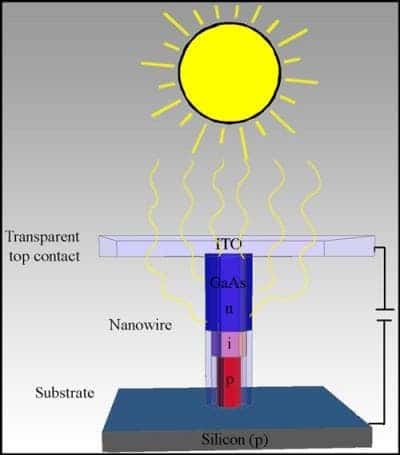One of the biggest hurdles the solar energy industry currently faces is efficiently transforming the incoming energy from the sun’s rays. Vast fields of solar panels are a common sight, but truth of the matter is their energy output is quite low, which puts them at a technical and economic disadvantage from other renewable solutions and, most important to consider, from conventional fossil-fuel based solutions as well.
A newly published paper in the journal Science, however, discusses the potential use of nanowires in conjunction with solar cells to drastically increase efficiency. The study made by scientists at Nano-Science Center at the Niels Bohr Institut, Denmark and the Ecole Polytechnique Fédérale de Lausanne, Switzerland, a single nanowire can concentrate the sunlight up to 15 times of the normal sun light intensity. To put this into more familiar terms, this suggests that solar cells in the future using this technology might be drastically improved. What’s really amazing, however, is that it suggests that the theoretical efficiency limit for solar cells – the “Shockley-Queisser Limit,” first discussed more 50 years ago – might be broken in a mere few years.

Nanowire crystals are cylindrical structures with a diameter of about 10,000 part of a human hair. Because of their incredible thinness, a nanowire crystal will cause sun light intensity to resonate in and around nanowires since the latter are smaller than the wavelength of the light. “Thus, the resonances can give a concentrated sunlight, where the energy is converted, which can be used to give a higher conversion efficiency of the sun’s energy,” the authors write.
The Shockley–Queisser limit or detailed balance limit, first calculated by William Shockley and Hans Queisser at Shockley Semiconductor in 1961, states that the maximum solar conversion efficiency of an ideal solar cell is around 33.7% assuming a single p-n junction with a band gap of 1.34 eV. The most popular and cost-effective solar cell material, silicon, can rend a maximum efficiency of 29%.
As a result of this discovery, the theoretical solar cell efficiency limits will very likely have to be increased, although many years of further research will be requires and many other after until the advancements might enter mass manufacturing.






